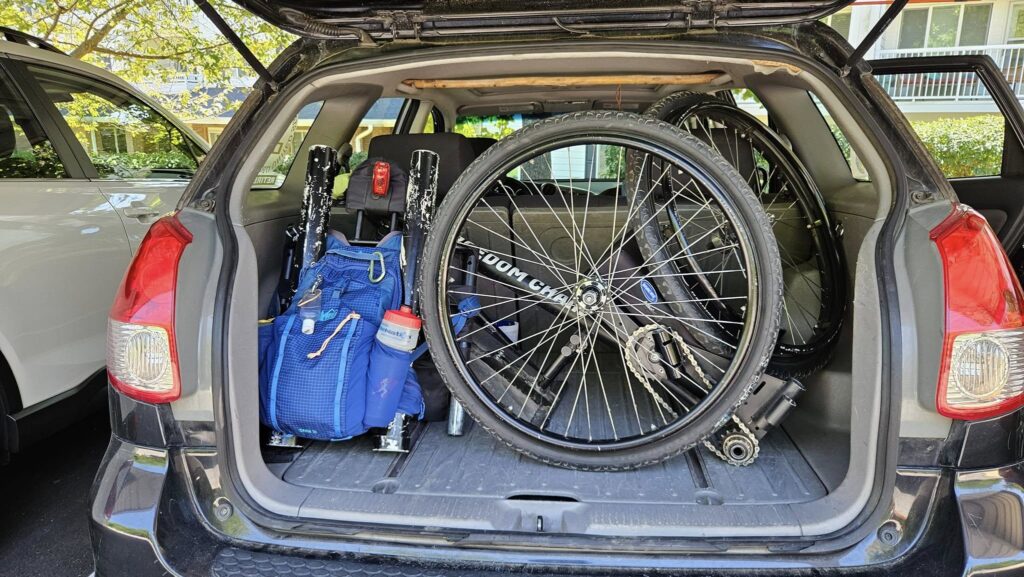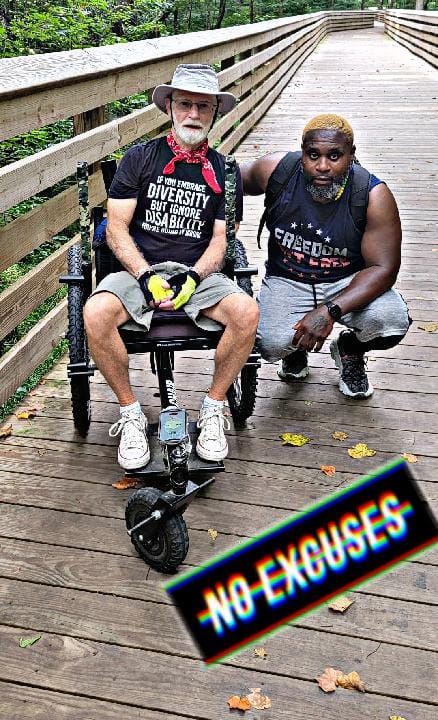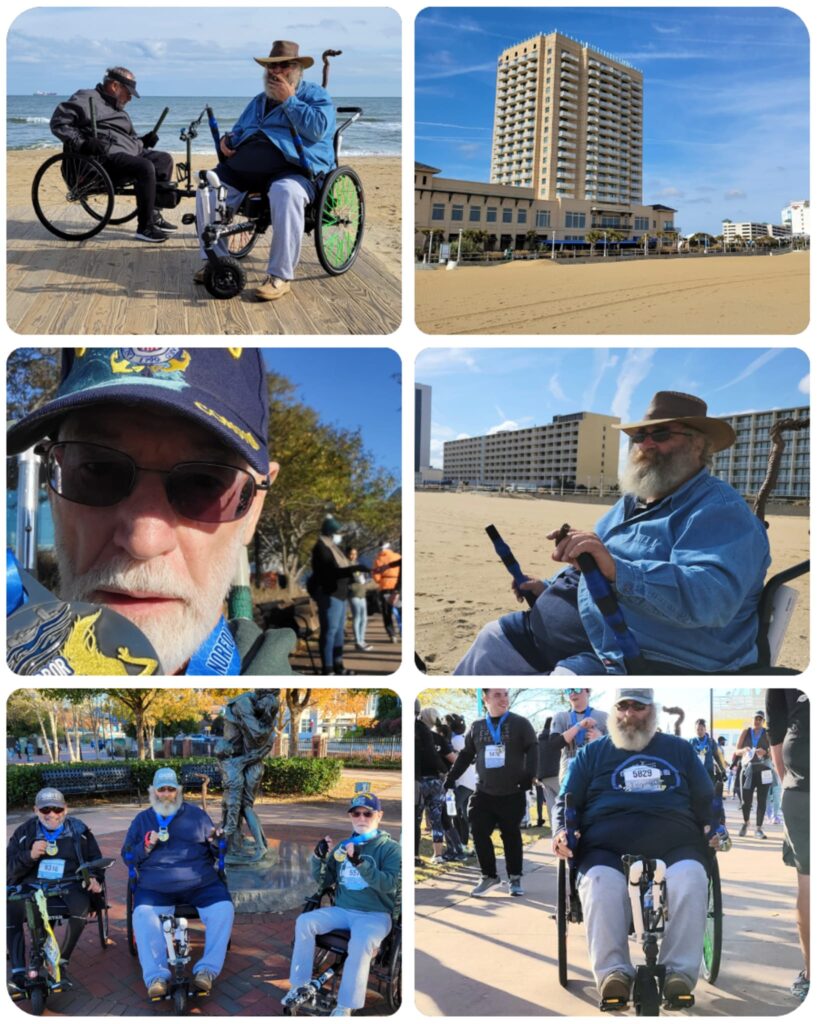Eight years ago, we had our first conversation with John Hollis, right before he received his GRIT Freedom Chair. Since then, John has logged thousands upon thousands of miles on daily training runs and in organized road races. Today, John is far from slowing down—in fact, he’s getting faster—and when this 70+ year-old United States Coast Guard Veteran isn’t pushing through his next mile, he’s supporting others in the GRIT community.
John graciously offers his free time to connect with folks interested in his all-terrain wheelchair, remains a consistent voice of positivity on GRIT’s social groups, and has even joined other GRIT-chair owners for out-of-state races and events. John has become a cornerstone of all things GRIT, and we were thrilled to have this conversation with him and, now, we are thrilled to share it with you!
Below is the first section of a two-part interview with John. We’ll cover John’s fitness journey, his recovery from major surgery, his process of equipment maintenance, the importance of road-race etiquette, the joys of solo riding, and more. Continue reading and stay tuned for part two!
GRIT: Good morning, John. How are you doing?
John Hollis: I’m good, considering the circumstances.
GRIT: Yes! How is your recovery going? You had heart surgery not too long ago.
John: It’s okay. It was major surgery. I can’t even use a wheelchair, crutches, or a cane until I’m cleared. That’ll be months.
GRIT: Was this an operation you had planned for? Was this a surprise procedure?
John: A few months ago, I was exercising and felt pressure in my chest. Of course, it was a Friday, and my doctor told me to “Get your tail in here immediately.” Turned out, I had some clogged arteries. They scheduled me for a stent, but over Memorial Day weekend, I couldn’t breathe and ended up in the ER. They attempted the stent, but I was too blocked—so they did a triple bypass a week later.
GRIT: Wow.
John: And recovering is tough. They open your sternum—it’s like having broken ribs. You’ve got to be careful not to re-break it. You just gotta wait. It’s been three weeks now, and I’m slowly getting better. I hope to be back in the Freedom Chair before fall.
GRIT: We hope so, too!
John: [laughs] I don’t know if you saw my last Facebook post, but it really is your guys’ fault that I’m recovering as well as I am. I’m serious. All of the exercise I got on the GRIT chair all winter and spring—because of that, my heart is doing fine. I was released from postoperative rehab in just three days.
GRIT: I’ll say, John, after all of these years, your name still comes up all of the time—when we’re talking about our most active riders, or the folks who are the most helpful to other people in the GRIT community, or—well, okay, and also when we’re talking about people who have gone through their share of replacement parts…
John: [laughs] I broke my first chair a lot! But not the second—thanks to the design changes. The reinforced seatback was a big improvement.
GRIT: You certainly test the chair, which we love! When you go out riding, do you follow a set route every time? Do you pursue new trails? How do you decide how far you’re going to go each day?
John: Well, around here, near High Point, North Carolina, there are greenways with some pretty good hills on them. Before I leave each day, I decide if I want to do two, three, six, or ten miles. I know the routes and distances, and I usually leave from the same parking lot.
GRIT: Do you seek out the hills? Do you avoid them?
“I was actually in better shape at the end of the shutdown than I was at the start. The GRIT chair was the perfect way to get out without congregating with lots of people.”
John: The route is uphill, then downhill—I alternate my effort, which they say is ideal for fitness. High intensity, low intensity, etc. I do the same route so often, I know how far things are and can choose my distance accordingly. The hills are a lot of work, but that’s where I get my exercise. And, I am immediately rewarded after every incline because I then have a downhill section. And of course, you see some really neat stuff while riding.
GRIT: What kinds of things do you see? Is there a lot of wildlife on the greenway?
John: Absolutely. I’ve seen deer and almost ran over a fledgling bird once! It fell right in front of me, but luckily I missed it. But, if you’re not out there, you don’t see this stuff. During COVID, I went out almost every day. I live in a senior facility, and the chair kept me from going stir-crazy. I didn’t go any crazier than I was before COVID [laughs].
I was actually in better shape at the end of the shutdown than I was at the start. The GRIT chair was the perfect way to get out without congregating with lots of people.
And it it was great. The chair gave me a kind of freedom since I can’t walk very far because my right leg has neuropathy, so I can’t walk very far. Having the chair was physically good for me and mentally good for me, and I met some nice people.
GRIT: Do you typically consider yourself a social rider? Or more of a solo rider?
John: I don’t ride for the social part—most people just say “Hi” and then I’m past them. I’ll stop and chat with a few folks I see regularly—like this one old guy…I’ve seen him for years. The first time I met him, he was ninety years old and riding his bicycle. [Laughs] He was the slowest bicyclist I ever saw, but he was out there. Somebody like that…you stop and talk to them.
But mostly, I go at my own pace. That’s important to me. If I’m not doing a race and it takes me an hour to do a 5K, that’s fine, you know? If I want to stop, I stop.
GRIT: Understood!
“And, you know, one of the great things about the [GRIT] chair is that it takes, what, three, four basic tools, and you’ve got everything you need, which I always carry with me in a pack on the back of my chair. So I pulled out a few of my tools and we fixed his skateboard.”
There’s another guy I saw a lot, riding a motorized skateboard. He went by me one day and said, “If you see me and you ever need any help, just let me know.” So a few months later, I see him and he asks me, “Hey, can you help me? My skateboard is broken.”
And, you know, one of the great things about the chair is that it takes, what, three, four basic tools, and you’ve got everything you need, which I always carry with me in a pack on the back of my chair. So I pulled out a few of my tools and we fixed his skateboard.
GRIT: So great—I love that your GRIT tools were all that he needed. How often do you cross paths with that particular skateboarder?
John: I might see him three or four times this summer, but that’s pretty often! You get to know people a little bit each time. And you know, I’m an old guy, so I have a hell of a time with names, but l say hello when we pass.
The old guy with the bicycle—he’d gotten into a bad accident awhile back, and the last time I saw him, he and his wife were driving in their car. They pulled over, he jumped out of the car, and I ended up taking pictures with both of them. What a nice guy.

GRIT: You’ve posted some awesome birding photos in the GRIT Facebook group. Do you bring your camera along with you on every ride?
John: Yeah, I always carry my phone, so in effect, I can stop and take pictures anytime. The camera you need is the camera you have. I’ve been a photographer since ‘74. The chair is great for photography—instead of trying to lean against something to stay stable, the GRIT chair is like a built-in frame that keeps me steady.
GRIT: What about people walking their dogs on the trail? How do they react to you pumping away in your chair?
John: [Laughs] Oh, yes. One time, a lady was walking by with a big dog—like a German-Shepherd-size one—and the dog just jumped into my lap. I guess it was tired of walking and saw me as a free ride back toward home. Usually, I see dogs at one park, where I kinda have to go round and round and round to get my miles in. The dogs get used to me after a few laps around the trail. But yeah, I’ve had some odd encounters.
John: Another time, a cherry tree had crashed on the Greenway and had broken stuff. So I got on Facebook and sent a message over to the parks and rec people—great folks—and they had someone out there almost immediately. Like, within twenty minutes, someone was out there working. The parks and rec folks got to know me pretty well.
GRIT: You joined the parks & rec department for some advocacy work, didn’t you?
“But mostly, I go at my own pace. That’s important to me. If I’m not doing a race and it takes me an hour to do a 5K, that’s fine, you know? If I want to stop, I stop.”
John: Yeah. I was on the Parks and Recreation Commission for a while. One thing I accomplished with them was in their quarterly event booklet—I got them to better label wheelchair-accessible events in their program. It’s a small thing, but it helps people plan better. Nobody wants to spend $10, $15 or more to go to an event and find out they can’t do it. I don’t mind if some trails aren’t accessible—some should be rough. But I want folks to know that before they go.
GRIT: These are the same conversations parks are having all over the country, and world—improving signage so that it includes more than a basic “easy/hard” rating, which isn’t terribly helpful for anyone.
John: Exactly. Just give people the information about slope and grade so they can self-choose. There’s a place called the Piedmont Environmental Center that has some trails that are definitely not wheelchair accessible. I love it there. Back before my leg went bad, I was on it three or four times a week. But I don’t really want that to become “wheelchair accessible.” I want it to stay rough, you know?
GRIT: So what happens when you’re riding and the trail gets too steep or rough?
John: Now, I can walk a bit, so I can get myself in a little bit of trouble and get out. Usually, though, I just turn around. I take it easy when needed. I’m out there for peace, not breaking any records. It’s quiet, and people are nice. I don’t think I’ve ever had a bad experience meeting people.
“I got them to better label wheelchair-accessible events in their program. It’s a small thing, but it helps people plan better […] I don’t mind if some trails aren’t accessible—some should be rough. But I want folks to know that before they go.”
There were a couple of moms and a little girl—she was maybe four or five years old, walking along with them. So, I asked the little girl from my chair, “Hey, you wanna race?”
She nodded and took off. She was a good runner. She didn’t run like a little kid. And finally, we stopped and I said, “You better go back to your mom!” She really was a heck of a runner.

GRIT: Do you ever encounter any other wheelchair riders on the greenway?
John: Not many, but lots of people do want to talk about the chair, especially the first few years I was out and using it. It seems like everybody has some relative who could use a GRIT chair. If I’m wearing a GRIT shirt, I’ll have them take a picture of it. Most people have their phone with them, so if anyone seems serious, I send them to the website.
GRIT: Back when you were looking for all-terrain wheelchairs, what made you select this one in particular?
John: When my wife and I were both looking for a chair—an off-road chair—I found these ones from Europe. They cost anywhere from $5,000 to $10,000, and I couldn’t imagine having to repair one if it ever broke. You’d be waiting forever to get a part. But then my wife found you guys, and you had already set up your government contract and all of that stuff. I went to my VA with all of the information.
GRIT: How was the process of getting adaptive equipment through the VA?
John: Well, at first they wanted to get me a walker instead. I said no. Then they offered a power scooter. I said no again. Power scooters are wonderful if you need them—they absolutely are great. But the problem with those things is that they can make people lazy, including me. In a scooter, if you don’t have to do something, you just don’t do it.
I told the VA, “I’m not taking that. Here’s what I want. This is the thing. It will give me exercise and get me around.” The VA guy eventually said yes.
GRIT: Have you ever thought, Shoot, I should have gotten that scooter instead?
John: Ha, well, there’s gonna be a time, not that far in the future, that I will need one…but until then, no. Hell no. I have never regretted getting the GRIT chair.
GRIT: Would you say your rides are more about the mental or physical benefits?
John: Both. My right leg has neuropathy, so walking is tough. But the chair lets me get out, get a good sweat going, take photos, and settle my mind. It is serenity. And it keeps my temper in check (just ask my wife). I don’t get mad at her, but I get mad at things. I get mad at myself. And so I go out there. And I don’t get mad when I’m out there. It just really settles me down.
“I don’t get mad when I’m out there. It just really settles me down.”
GRIT: What do you do in the winter?
John: There’s a step machine where I live that I use—I just don’t use the steps, only the arms to keep my upper-body strength up. That way, when spring comes and it is warm enough to ride, I can go out again. The chair gives me a reason to exercise even when I can’t go out, because I look forward to using the chair in the springtime and summer.
In winter, I won’t go out unless it’s above 60. It used to be 17 degrees when I was younger and living in New York, but now that I am an old fart [laughs] it has to be 60 degrees for me to go out.
GRIT: Have you always maintained an active lifestyle?

John: It’s been on and off. I was in the military for 27 years. There were times when I had no time to exercise. Back when I was stationed in Puerto Rico, I was running all the time. And then I met this gal, and my interests were no longer all about exercising…
The service paid for me to go to Syracuse University, which was one of those times I didn’t have much chance to exercise. I got fat. For me, I was fat. And then I worked it off running and stuff. After retiring from the military, I worked as a newspaper editor and got back into exercising. Photography and nature walks kept me going until my ankle gave out. That’s when I got the Freedom Chair.
GRIT: You’ve done plenty of racing with the GRIT chair, haven’t you?
John: Yeah. When I first got the chair, I could do three miles in just under an hour. I was ecstatic with that. But my last 5K race? I did it in under 24 minutes. The weather was perfect, like 65 degrees, the slopes weren’t too steep, and it was just the ideal course.
GRIT: That’s incredible.
John: I had a great time. And I knew I came first in the “above 70” group, which felt good. But, after the race, I was waiting to get called up in the “above 70” group and they didn’t call me. I thought, Well, that’s weird. So I went back to my car, came home, and wrote an email to the guy in charge and asked why I wasn’t called up. He said, “Well, you had an unfair advantage because of your chair.”
I told him the first 5K I did took me fifty-six minutes, and the next one took me even longer. Nobody complained when I was coming in third and fourth in my age group, but now that I came in first, people complain. Between my first race and this one, though, the only thing that changed was me.
I don’t usually mind what place I came in, as long as I am happy with the run. Everybody at that race knew I came in first. I beat all of those other old farts. But that incident soured me. I haven’t raced since.
Thank you for reading Part One of our conversation with John! Stay tuned for Part Two! If you have any questions about GRIT or the GRIT Freedom Chair, please feel free to contact us any time at 877-345-4748 or info@gogrit.us.